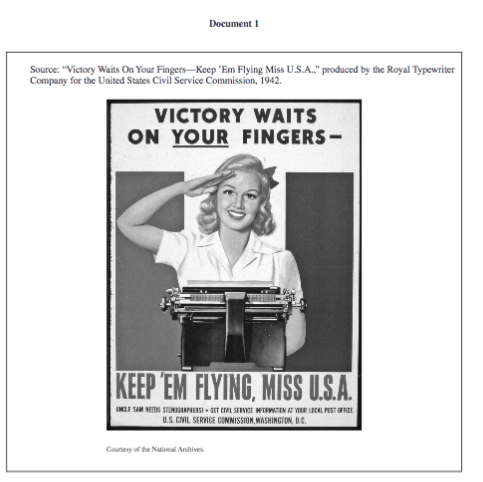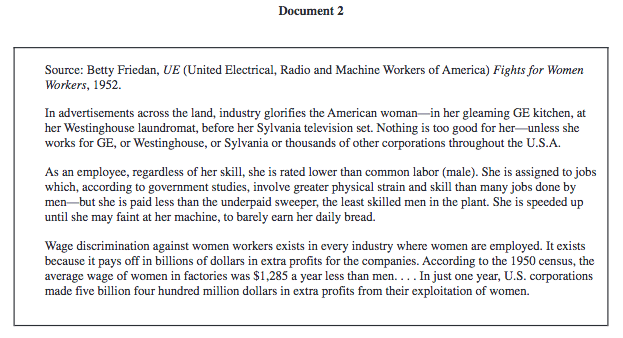Document Based Questions tend to freak students out the most on the APUSH exam. This is understandable; not only do you have to read documents, you have to write a coherent essay about them.
Eeek!
However, we’ve got you covered here at Magoosh. For a step-by-step breakdown of what you need to do to write a Document Based Question (DBQ), check out my other blog posts on 3 Steps to a DBQ Essay that Works and How to Write a DBQ Essay. This post, though, will focus on what other students have done to make their Document Based Question essays successful.
I will take you through one DBQ on a prior APUSH exam and give you the ins and outs, and the dos and don’ts. At the end, I will provide a link to a DBQ essay for you to practice some of the things that successful test-takers have done. There, you can compare your essay to the scoring notes provided by College Board. In fact, everything I present on this post will be provided by College Board – you can (and should!) check out their website for more tips.
Sound good? Let’s go!
Document Based Question #1
This is taken from the 2016 APUSH Exam. The DBQ for this section asks you to do the following:
Explain the causes of the rise of a women’s rights movement in the period 1940–1975.
You will have 55 minutes to answer that question. The College Board suggests 15 minutes for reading and 40 minutes for writing, although if you are a fast and careful reader, you can start writing before your 15-minute reading period is done.
I won’t post all of the documents that you have to reference (there are 7 after all!), but the following two documents are representative of the types of documents you will encounter on a DBQ.


As you can see, there’s a mix of photographs, advertisements, and text that you will be expected to incorporate into your essay.
Still with me? Good. Next, let’s look into what an essay should have in it.
Scoring Notes for Document Based Questions
The following (including descriptions) comes straight from the APUSH scoring notes. I’ll break down parts of it later to make sure that you understand what they want to see.
Your DBQ essay should have the following (for a maximum of 7 points):
- Thesis: Present a thesis that makes a historically defensible claim and responds to all parts of the question. The thesis must consist of one or more sentences located in one place, either in the introduction or the conclusion.
- Argument Development: Develop and support a cohesive argument that recognizes and accounts for historical complexity by explicitly illustrating relationships among historical evidence such as contradiction, corroboration, and/or qualification.
- Use of the Documents: Utilize the content of at least six of the documents to support the stated thesis or a relevant argument.
- Sourcing the Documents: Explain the significance of the author’s point of view, author’s purpose, historical context, and/or audience for at least four documents.
- Contextualization: Situate the argument by explaining the broader historical events, developments, or processes immediately relevant to the question.
- Outside Evidence: Provide an example or additional piece of specific evidence beyond those found in the documents to support or qualify the argument.
- Synthesis: Extend the argument by explaining the connections between the argument and ONE of the following.
- A development in a different historical period, situation, era, or geographical area.
-
- A course theme and/or approach to history that is not the focus of the essay (such as political, economic, social, cultural, or intellectual history).
Yes, it’s a lot. But students have done it before, and so can you! Just because of the limits of space, I am only going to show you what to do – and what not to do – on the parts where I have seen students struggle most: thesis and synthesis.
Thesis Statements for Document Based Questions
Your thesis statement is the bread and butter of any essay you write for the APUSH exam. As I have stated before in previous posts, you should spend the most time on your thesis because a strong thesis will guide the rest of your essay.
But what makes a thesis strong? As mysterious as that question may seem, it is relatively straightforward:
A strong thesis directly answers the question being asked by referencing specific times, movements, or ideas.
It’s that simple! Well, it’s sort of simple. Developing a strong thesis is hard work, but let’s begin at the beginning. Here’s the question being asked: Explain the causes of the rise of a women’s rights movement in the period 1940–1975.
Notice that the question asks for causes, meaning MORE than one. Also, notice that the question gives you a defined time period to work with. Therefore, your thesis shouldn’t deal with any events, ideas, or people outside of that time period.
Let’s look at two student examples.
Example Thesis #1:
The women’s rights movement arose as a result of women’s experiences with inequality at work and the influence of other rights movements.
Does the student directly answer the question being asked?
Yes. According to the student, the women’s rights movement was caused by the experiences of women dealing with inequality at work and the influence of other rights movements in the same time.
Is the student being specific?
Yes. I know that this student will be organizing their essay in two big chunks: inequality in the workforce and civil rights movements.
Notice that this student didn’t give the longest answer possible, and the response was not necessarily the most eloquent, but that student still got a point for their thesis.
Example Thesis #2:
The woman’s rights movement was the product of unfair treatment in economics, politics, and society.
Does the student directly answer the question being asked?
Well, yes, but I am unclear what “economics, politics, and society” means.
Is the student being specific?
Not at all. There could be thousands of things that go under economics, politics, and society – and many things could be considered “unfair” – so I have no idea what the student will be arguing in this DBQ.
Thesis Statement Dos and Don’ts
DO:
- Directly answer the question being asked.
- Be specific.
- Write a thesis statement like the first example.
Don’t:
- Answer the question in a confusing way or answer some other question you think the test SHOULD be asking.
- Be general.
Synthesis in Document Based Questions
This is a newer component of the DBQ. You need to demonstrate your understanding of history by being able to go beyond the documents they provide you and make connections between different parts of history. This does NOT mean that you need to spend all of your time racking your brain for more evidence. However, it does mean that you should have a solid understanding of US History and can extend your argument to other time periods or themes. Let’s look at some student examples to explain what I mean.
Student Example #1:
The conditions that helped cause the rise of the women’s rights movement in the 20th century were similar to those that helped cause the rise of a movement for greater women’s rights in the 1840s. In both periods, calls for greater rights for African Americans led women to demand more of a voice in social and political reforms.
This student explains that the conditions for women’s rights movements were similar in two different time periods, extending the argument beyond this one moment in US history.
Student Example #2:
A development in a different historical period was when Alice Paul went on hunger strikes and protests in from of the White House to gain attention on passing an amendment that would give women their rights. Paul’s fight for women’s rights started with trying to get equal voting rights for women. This links to how in 1940-1975 women were fighting for equal rights in wages and other important rights.
This student makes a connection to another time period by arguing that the fight for equal rights did not begin in 1940; instead, women had been active for some time in US history to achieve equal rights.
Student Example #3:
The Seneca Falls convention also served to help inspire women around the world to gain equal rights. The speech given clearly stated the way things were being conducted was unconstitutional and women should not be socially inferior to men.
Unlike the first two student responses, this third response does NOT connect back to the time period in the question. I am unclear from this student response whether the connection is gaining equal rights for women, the persistence of inequality, or the changing interpretations of the Constitution. This student did not receive a point for the synthesis criteria.
Synthesis Dos and Don’ts
DO:
- Connect back to the time period of the question.
- Be specific.
Don’t:
- State something that you feel is an “obvious” connection, but never make a connection yourself. You should be doing that work for your reader.
- Be general.
Document Based Question #2: Your Turn!
Although I haven’t outlined every single component of the DBQ, you should look at the two blog posts I linked to at the beginning of this article for more references.
But now it’s time for you to dive in! You will only get better by practicing.
You should practice with the 2015 Document Based Question 1. In that document, you will have access to the questions and sample student responses.
Good luck, and let me know how it goes!




Leave a Reply